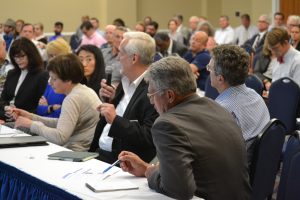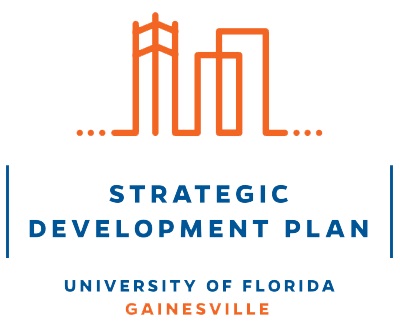 National and international experts discussed the University of Florida’s Strategic Development Plan at an Aug. 31 symposium, noting successes and challenges they faced in their own institutions’ and companies’ development projects.
National and international experts discussed the University of Florida’s Strategic Development Plan at an Aug. 31 symposium, noting successes and challenges they faced in their own institutions’ and companies’ development projects.
“University Towns: Perspective on strategic development planning” was held in the Presidents Ballroom at Emerson Alumni Hall and featured a diverse panel of speakers from the public and private sectors.
UF’s Strategic Development planning process, which began in February, is currently entering its third and final phase. The plan’s goal is to provide a roadmap for the university and surrounding community’s future that supports UF’s rise to preeminence by identifying the best opportunities for wise growth, economic viability and livability over the next 40 to 50 years.“In strategic planning initiatives such as this one, it is crucial to learn what other institutions have done to build off of their successes and learn from their challenges,” said UF Senior Vice President and COO Charlie Lane. “This symposium offered great insight into how strategic development plans have played out in other university towns across the country.”
Lane kicked off the symposium by giving a brief history and overview of UF’s Strategic Development Plan. He noted that some important considerations during the planning process include asking what a preeminent university looks like and exploring what distinguishes a good college town from a great college town. He also emphasized the symbiotic relationship of the University of Florida and the City of Gainesville, asking how each entity influences the other.
The first guest speaker, UGA’s and Georgia Tech’s executive director of academic partnerships, Daniel Sniff, discussed the work he has been involved in over the years in transforming UGA from having a campus core dominated by sprawling parking lots to one that more efficiently uses its space for academic buildings, green spaces and classroom innovations.
“People who come to our campus, to your campus, say this is who we are as a society,” Sniff said. “Our future leaders are being trained in this place. It is our legacy for the future.”
The morning session also featured speakers from the University of North Carolina at Chapel Hill, the University of Virginia, Space Syntax Limited and the City of Dublin, Ohio.

UVA campus architect Alice Raucher, who spent many years at Yale University before relocating to Virginia, noted the importance of maintaining strong town and gown relations based on observing an acrimonious situation between Yale and the city of New Haven, Connecticut. When a new Yale president worked to improve the school’s relationship with the town, development began to thrive and local perceptions of the school were greatly improved.
Other topics addressed during a brief Q&A session with the speakers included the importance of avoiding gentrification during new development, preserving the character of historic neighborhoods and maintaining transparency throughout the planning process.
The afternoon session included a recap of the morning session by Lane, a presentation from consultants from the architecture and planning firms hired by UF, Elkus Manfredi and DumontJanks, a panel discussion featuring the morning speakers and a public Q&A.
Four of the main concepts discussed in the consultants’ presentation were the importance of collaboration within the university and the Gainesville community, how strong neighborhoods surrounding campus are crucial to the plan’s success, UF’s role as a land-grant university, and the concept of the New American City.
Gregory Janks of DumontJanks noted that Florida is ground zero for many of the biggest challenges facing America today. He said Gainesville can function as a laboratory to address these issues and could become the New American City – a community that thrives on an urban economy driven by innovation, and holds issues like sustainability, social and economic equity, education and safety among its top values.
In the afternoon, Lane also identified several themes to keep in mind that arose from the guest speakers’ discussion of their own projects: town and gown relations, a corridor connecting campus and downtown, gentrification issues, the importance of the university and town to invest in the plan, and that it is crucial for all parties involved to be committed to a long-term plan and provide strong leadership and vision.
The symposium concluded with a brief Q&A session from the general public that again emphasized the theme of creating and maintaining a strong partnership between UF and the city of Gainesville, not only for the success of the Strategic Development Plan but for the quality of life and well-being for UF employees and Gainesville residents.
Strategic Development Plan Public Meeting Sept. 28
The next Strategic Development Plan meeting will be a public forum focused on campus related issues, including teaching, research and service, as well as quality of life issues for students and faculty. It will be held Sept. 28 at 5:30 p.m. in the Chandler Auditorium at the Harn Museum of Art.
